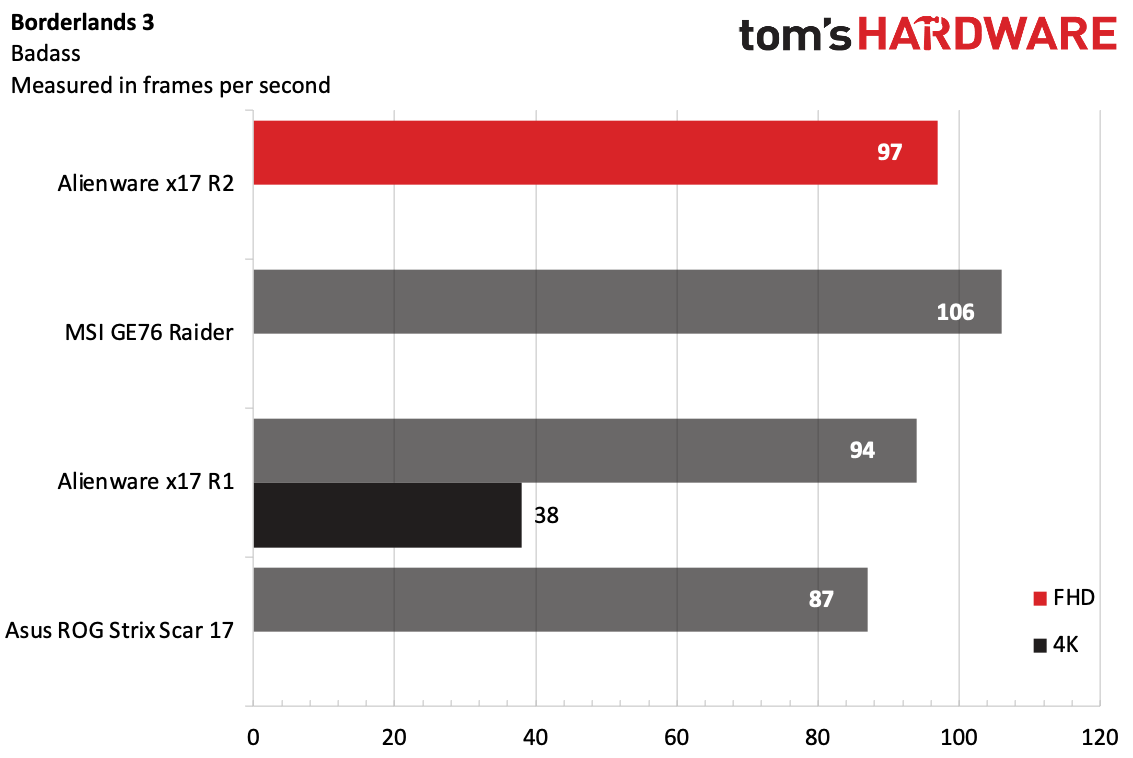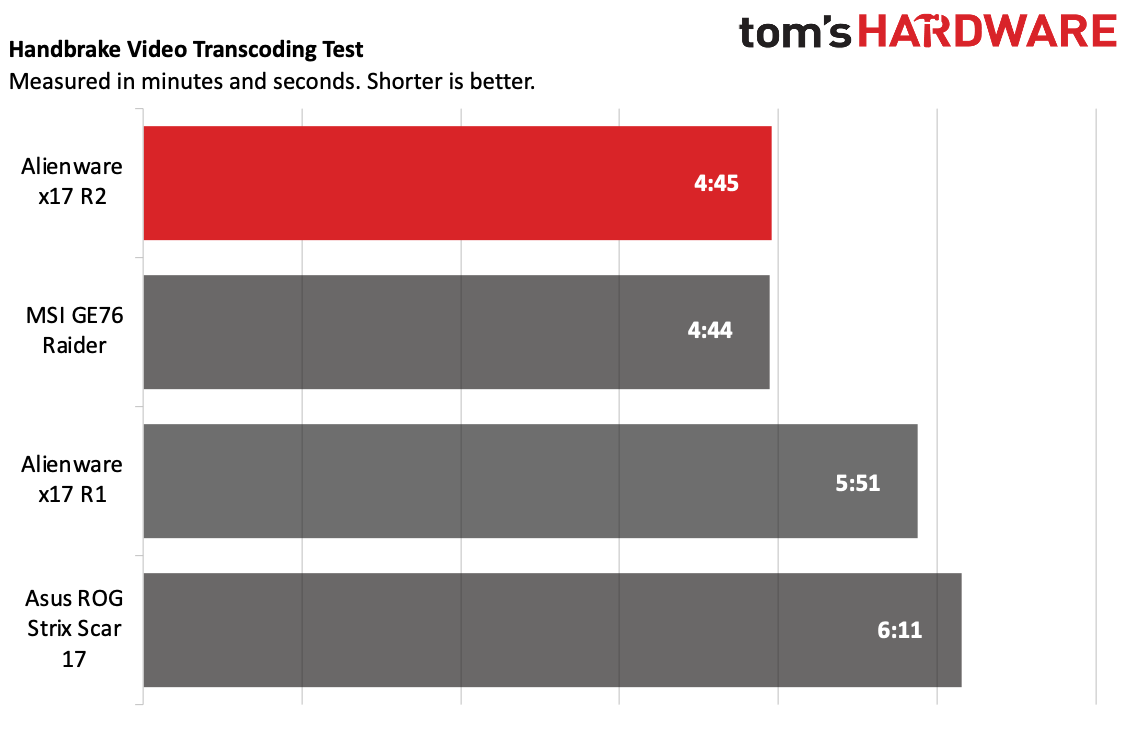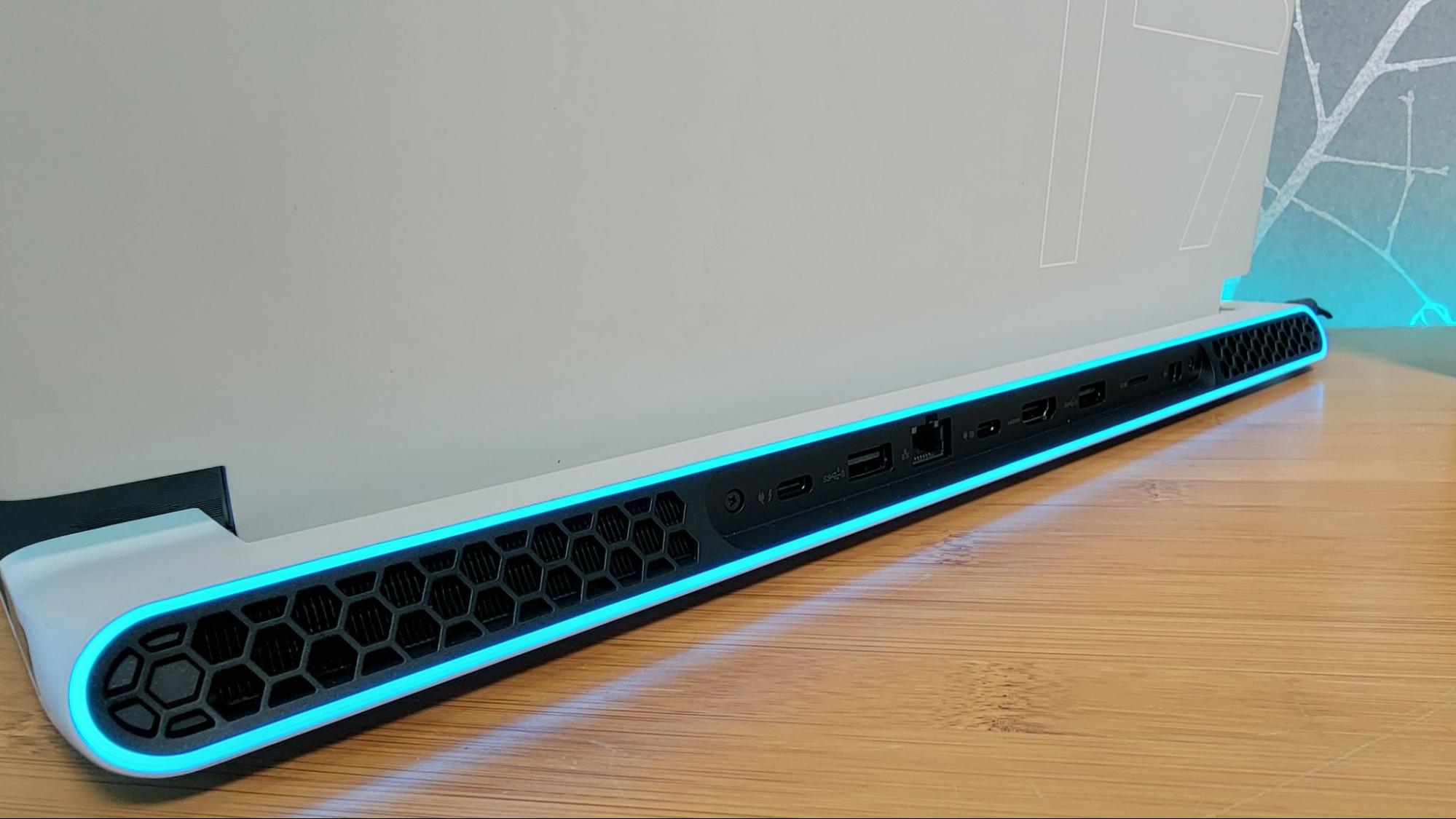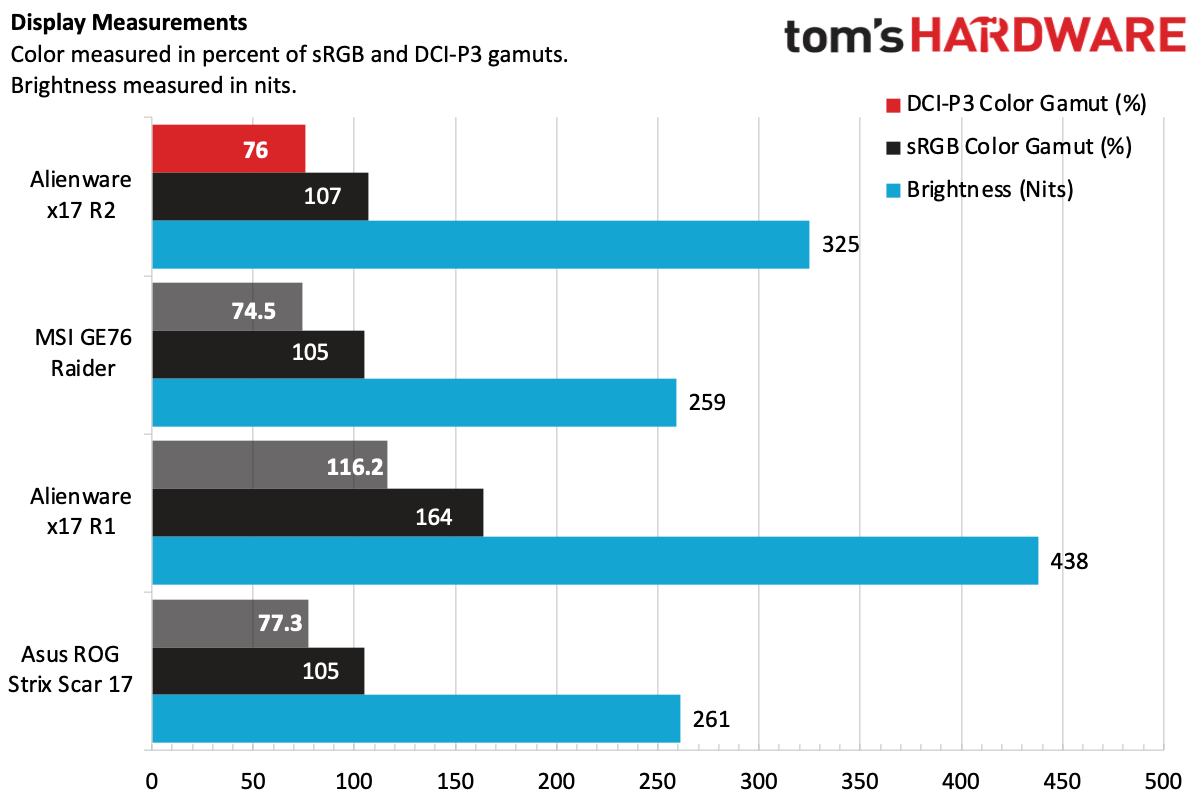Tom's Hardware Verdict
With new top-end Intel and Nvidia components wrapped in arguably the nicest-looking gaming laptop shell on the market, the Alienware x17 R2 is impressive, and its mechanical keyboard option feels great. But MSI's competing GE76 Raider performed a bit better on our gaming tests and has a bigger battery.
Pros
- +
+ Excellent productivity and gaming performance
- +
+ Stunning design
Cons
- -
Expensive
- -
A bit larger and heavier than the competition
- -
Battery life could be better
Why you can trust Tom's Hardware
When you're plunking down more than $4,000 on a portable gaming rig, two of your top priorities are likely to be cutting-edge top-end components and stunning aesthetics. The former will make sure your frame rates stay butter-smooth for years to come, while the latter will make you want to use your machine more often, whether you're streaming at home or out and about in the world.
On both of those counts, Alienware's updated x17 R2 excels. Externally, it's the same sleek, 0.84-inch thick extraterrestrial beast that we looked at last fall. The design's still a stunner, and the optional mechanical Cherry MX keyboard feels as satisfying to type on as some of the best gaming keyboards we've used. The only real downside of the design, as far as I'm concerned, is that all the ports are at the back. But hey, some people like that.
On the inside, though, is where the x17 R2 gets exciting. The company has updated its configuration options, adding both Intel's new top-of-the-line 12th Gen Core i9-12900HK, as well as Nvidia's new flagship mobile RTX 3080 Ti. The company sent our review unit with those parts, plus 64GB of DDR5 RAM and a pair of 2TB Samsung 980 Pro PCIe 4.0 SSDs in RAID, delivering possibly the fastest boot drive we've seen to date among the best gaming laptops. Note that Dell doesn't guarantee you'll get these drives; the company says it uses multiple drive companies, but that any buyer who chooses a 512GB or higher SSD will get a PCIe 4.0 drive or drives.
Of course, all that cutting-edge high-end hardware adds up. Alienware says our configuration will sell for $4,799. You can save some money by opting for half the RAM (32GB is plenty for gaming) and nixing the mechanical keyboard option. That drops the price down to $4,499. And if you can live with a single 1TB SSD, the price drops to $3,849. Personally, while we aren't sure we'd pay extra for all that RAM and storage, the $50 upgrade for the mechanical keyboard is worth it. The Cherry MX switches on our review unit feel excellent, although there is a fair amount of metallic ping noise on some of the keys.
With brand-new top-end components and a stunningly designed and built chassis, is the Alienware x17 the best gaming laptop you can buy? That depends in part on how you use your rig and how much you value style and battery life over the highest frame rates possible.
Design of the Alienware x17 R2
The shell of the Alienware x17 R2 is the same as the R1 model we looked at last fall. But that's far from a bad thing given that it's still arguably the sleekest, most premium-feeling gaming portable on the market. At 0.84 inches thick and wrapped in magnesium and aluminum, the laptop feels as good as it looks. And in the "lunar light" (white) finish of our review unit, the laptop looks both futuristic and understated (for a gaming laptop). There's RGB lighting on the keyboard, the alien head logo on the lid, and an oval that runs around the vents and the ports at the back adds a tasteful amount of customizable glow.
All that said, while the Alienware x17 R2 is slim for a high-end gaming laptop, it's not exactly small or light. At 15.72 x 11.79 x 0.84 inches (399 x 300 x 21.4 mm), it's a bit bigger than MSI's similarly powerful GE76 Raider (15.63 x 11.18 x 1.01 inches) and Asus Strix Scar G733 (15.55 x 11.11 x 1.08 inches). And at 6.82 pounds fully kitted out, the Alienware is also the heaviest of the competition, as the MSI is 6.39 pounds and the Asus just is 5.95 pounds. Also note that despite its extra heft, the Alienware has an 87 WHr battery, while the Asus has a 90 WHr, and the MSI has a 99 WHr battery.
Nearly all of the Alienware x17 R2's ports are found at the rear, save for the headphone jack on the right side, near the back, and the barrel connector for the charger on the left edge.
Surrounded by the RGB light ring and flanked by vents on the back edge, you'll find a Thunderbolt 4 port, two USB 3.2 Gen 1 Type-A ports, gigabit Ethernet, USB 3.2 Gen 2 Type-C (which also works for charging, though you'll need to use the brick for the fastest charging), a microSD card reader, HDMI and a mini DisplayPort.
Get Tom's Hardware's best news and in-depth reviews, straight to your inbox.
The connectivity here is ample, though lots of people would find it more convenient to have some of these ports on the sides as well as the rear of the laptop. If that's important to you, most competing big-screen portables (like the MSI and Asus models mentioned above) feature more traditional port layouts.
Alienware x17 R2 Specifications
| CPU | Intel Core i9-12900HK |
| Graphics | Nvidia GeForce GeForce RTX 3080 Ti (16GB GDDR6, 175 W max graphics power) |
| Memory | 64GB DDR5-4800 |
| Storage | 2x 2TB PCIe Gen 4 M.2 SSD |
| Display | 17.3-inch, 1920 x 1080, 360 Hz |
| Networking | Killer Wi-Fi 6E AX1675i, Bluetooth 5.2 |
| Ports | Thunderbolt 4, USB 3.2 Gen 2 Type-C, 2x USB 3.2 Gen 1 Type-A, USB 3.2 Gen 2 Type-A, Ethernet, microSD card reader, HDMI, mini DisplayPort |
| Camera | 720p |
| Battery | 87 WHr |
| Power Adapter | 330 W |
| Operating System | Windows 11 Home |
| Dimensions (WxDxH) | 15.72 x 11.79 x 0.84 inches / 399 x 300 x 21.4 mm |
| Weight | 6.82 pounds / 3.09 kg |
Gaming and Graphics Performance on the Alienware X17 R2
We don't expect massive gains between the RTX 3080 performance (as we saw it in the Asus and last-gen Alienware laptops) and the RTX 3080 Ti performance from the x17 R2 we're looking at here as well as in the MSI GE76 Raider. The new GPU should deliver some advantage at high resolutions, and the new CPU should help at 1080p. But since the panel that Alienware shipped with this laptop is 1080p, we'll only get a chance to see its advantages at the lower resolution.
Still, when I played through the Meridian Outskirts area in Borderlands 3 on the badass preset, the x17 R2 delivered smooth frame rates between the mid-90s and 130 fps. Thanks to the display's insanely high 360 Hz refresh, everything looked extremely smooth, and the responsive, tactile feel of the keyboard made every moment more enjoyable.





On the Shadow of the Tomb Raider benchmark on its highest settings at 1080p resolution, the new Alienware x17 R2 turned in a score of 107 frames per second (fps). That's five frames behind the MSI, but 13 fps ahead of the previous-gen Alienware (94 fps) and 20 fps ahead of the Asus (87 fps) at the same resolution and settings.
Grand Theft Auto V saw the new x17 R2 deliver 129 fps. That's the poorest showing so far for Alienware, as the MSI delivered 10 fps better (139 fps) at the same resolution and settings. Even the last-gen x17 R1 tied the new model, with the same 129 fps.
On Far Cry New Dawn (ultra settings, 1080p), the Alienware x17 R2 and its 3080 Ti made up some ground, delivering a 117 fps that bested both the MSI (113 fps), and everything else here. The Asus with its AMD CPU brought up the rear with a still-smooth 90 fps on the same test and resolution.
Switching to Borderlands 3 on "badass" settings at 1080p, the x17's score of 97 fps was again 10 fps behind the MSI (106 fps), but ahead of the last-gen systems. Again the Asus brought up last place with 87 fps.
The Alienware x17 R2 again took a loss to the MSI in our Red Dead Redemption 2 test (1080p, medium), where its 78.3 fps was eclipsed by the MSI's 82 fps. Interestingly, even the previous-generation Alienware x17 did better here, with an 81 fps result.
On gaming notebooks, we stress test the system by running the Metro Exodus benchmark on RTX settings 15 times, simulating about half an hour of gameplay. The game ran at an average of 75.98 frames per second across the runs, starting off at 80.41 fps, before dropping into the 75 range after the first three runs.
The performance cores on the Alder Lake processor ran at an average of 2.9 GHz on the stress test, while the efficiency cores hit an average of 2.25 GHz. The CPU package temperature measured an average of 81.4 degrees Celsius (178.5 degrees Fahrenheit). Interestingly, while the Alienware x17 R2's CPU temperature was lower than the similarly equipped MSI on the same test (81 vs 85 degrees), the MSI laptop's Performance cores ran a full GHz higher (2.9 GHz for the Alienware vs 3.94 GHz for the MSI). And the MSI ran the game faster as well, delivering an average of nearly 84 fps, versus the Alienware's 76 fps. Perhaps Alienware is implementing some power limits to avoid the thermal throttling we saw on the MSI.
Oddly, HWinfo, which we use to measure the above data, also failed to show any GPU info in our Alienware review unit. So we can't at this point post the GPU clock speed or temperatures.
Productivity Performance of the Alienware x17 R2
To get a sense of how Alienware's latest 17-incher performs compared to other laptops, we put it up against MSI's GE76 Raider, which shares the same Core i9-12900HK CPU and RTX 3080 Ti as our Alienware review unit. And to get a sense of how it stacks up against previous systems, we also tossed performance numbers from the Alienware x17 R1 we tested in 2021 (Core i7-11800H, RTX 3080) and the Asus ROG Strix Scar 17 G733 (AMD Ryzen 9 5900HX, RTX 3080).



On Geekbench 5, a synthetic test that aims to track general performance, the 12900HK-packing Alienware x17 delivered a single-core score of 1,842 and a multi-core result of 13,710. That's slightly ahead of the MSI's showing of 1,833 (single) and 13,456 (multi), but much further ahead of the previous-gen x17, with its single-core score of 1,539 and all-core showing of just 9,024. That's a whopping 52% increase from last year's model, though we also jumped from an 11th Gen i7 to a 12th Gen i9. The Ryzen-based Asus G733 had the worst showing here, managing just 1,487 (single-core) and 8,231 (multi-core).
The pair of Samsung 980 Pro PCIe 4.0 SSDs in the new Alienware trounced the competition in our 25GB file transfer test, taking just 11.8 seconds to move the mixed collection of files, for a speed of 2,268 MBps. The 1,774.47 MBps showing of the MSI machine was the next closest. And last year's x17 was over 1 GBps slower, delivering a speed of 1,227.
On our Handbrake test, in which computers transcode a 4K video to 1080p, the Alienware again impressed. As we'd expect, its 4 minutes, 45 second showing was basically even with the MSI (4:44), which has the same CPU and GPU. But the next-closest competitor was last year's x17, which was more than a minute slower (5:51).
Display on the Alienware x17
The Alienware's 1080p display delivered 107% of the sRGB color gamut and 76% of DCI-P3. That puts it just slightly ahead of the MSI and Asus displays in terms of color. But with an average brightness of 325 nits, the new Alienware is a fair bit brighter.
While the panel's colors weren't as vivid as on the OLED TV I use as my main gaming monitor, when I played Borderlands 3, the stylized dystopian scenery and characters looked far from dull. And thanks to the high refresh and powerful components, every title I played always looked smooth.
Note, though, that the previous Alienware x17 R1 we tested with a 4K 120 Hz panel delivered better color and even more brightness (438 nits). If you aren't after maximum refresh rate over everything else, we'd opt for the 4K panel when configuring the system from Alienware.
Keyboard and Touchpad on the Alienware x17 R2
If there's an upgrade I'd recommend for everyone opting for the Alienware x17 R2, it's the $50 Cherry MX mechanical keyboard. This came with our review unit, and in terms of just switch feel and snapiness, it's better than some of the best gaming keyboards I use in my day-to-day work and gaming life.
I can't think of the last time I used a laptop keyboard that felt this satisfying. That said, if you're a true keyboard enthusiast who is annoyed by metallic case ping sounds, the mechanical keyboard here has that aplenty, and it varies quite a bit from key to key. Personally I think the feel of the keyboard (and its roomly layout) far outweigh any pinging sound issues, but that may not be the case for everyone.
The only odd thing about the keyboard's layout is the extra column all the way to the right, which houses dedicated volume, mute, and mic mute keys. Their non-standard positions will take some getting used to, but in my case I didn't find myself hitting them accidentally. I would also have liked to see dedicated media control buttons, but you can at least program the F2-F6 keys with macros.
The touchpad isn't exactly spacious at about 2.4 x 4.8 inches, but it's big enough for Windows gestures, at least with my mid-sized hands. Some may prefer something larger, but the vast majority of gamers are going to want to use one of the best gaming mice, anyway.
Upgradeability of the Alienware x17
Some engineer at Alienware deserves an award for just how easy the x17's internals are to access. There are eight standard Philips head screws on the bottom of the laptop. After removing all but the two that are captive (one on each side), the bottom pops off so easily that I didn't even have to think about finding a spudger or an old credit card for prying purposes.
Inside, both the two SO-DIMM slots and two M.2 SSDs are accessible. All four upgradable slots were occupied in our review unit. The SSDs are housed under heat spreaders with thermal pads, but they are easy to get to and remove – you just need to remove yet another small screw for each drive.
Also, note the Alienware x17's 87 WHr battery in the image above: It isn't quite as beefy as the 99 WHr power box that the MSI Raider sports. As you might expect, that leads to differences in unplugged run time between the two systems that sport very similar components, which will see in the next section.
Also visible here is the x17's four-fan cooling system, which often kicked on even when the machine was idling at the desktop. Expect fan noise to be a constant companion when gaming (and most of the rest of the time too). That said, the fan noise on the x17 R2, while prominent when gaming, isn't close to the loudest or highest-pitched I've heard from a high-end gaming laptop under load.
Battery Life on the Alienware x17
You'll want to keep the x17 R2's power brick handy whenever you're using the system. No high-end gaming laptop sports stellar battery life, but the x17 R2 with its top-end components is only likely to last a few hours under the best of circumstances.
On our battery test, in which laptops continuously browse the web, stream video and run OpenGL graphics tests in the browser, all while connected to Wi-Fi with the screen at 150 nits, the x17 R2 conked out at the 3 hour and 7 minute mark. That's not awful as far as powerful gaming laptops go, but the MSI lasted nearly an hour longer (4:05), last year's x17 R1 lasted almost 90 mins longer (4:31), and the AMD-powered Asus held on for 3:44.
Webcam on the Alienware x17 R2
The good news about the Alienware x17 R2's webcam is that it includes Windows Hello support. But its 720p sensor produces fuzzy images under the best conditions. And in anything much below mid-day level sunlight, its colors were subdued and dull. Sure, the camera here will get you through the occasional work meeting or virtual event just fine. But if you expect more than that you'll want to invest in one of the best webcams.
Audio on the Alienware x17 R2
I listened to the 20th Anniversary remastered edition of Assemblage 23's album "Failure," and the pair of 4-watt speakers did an OK job when I was sitting in front of the laptop. But stepping a few feet away, the low-end of the audio dropped off dramatically, leading to a thin, muddy sound. I tried to see if software could help here. But the pre-installed Realtek Audio console only let me adjust the balance from left to right and the volume. And I did not spot an equalizer in Alienware's Command Center Software.
Still, this is going to be less of an issue for gaming. During my rounds of Borderlands 3, I had no major complaints. But if you often use your laptop for music while you aren't sitting right in front of it, you'll want to invest in some kind of speakers, whether they be of the desktop or Bluetooth variety.
Software and Warranty on Alienware x17 R2
As with all new consumer-focused Windows laptops going forward, the x17 R2 ships with Windows 11 (Pro in our model, though most configurations ship with Home). Our review unit came pleasingly free of much of any extra OS cruft, save for the usual Office and Xbox links.
Alienware's Command Center is the primary piece of pre-installed software. With it you can tweak fan speeds, adjust audio, switch between power profiles, change lighting and check component usage. You can overclock the CPU here as well, if that's an option with your configuration. There are also the usual programs for basic support and audio tweaking, as well as Killer Intelligence Center for managing and monitoring network traffic. But overall, the software bloat here is pleasingly slim to none.
Alienware sells the x17 R2 with a 1-year warranty as standard, although you can bump that up as high as four years at purchase for an extra $440 (2 years is an extra $160).
Configurations of the Alienware x17 R2
As of this writing, Alienware sells the x17 R2 in four configurations, starting at $2,449 with a Core i7-12700H, an RTX 3060, a 512GB PCIe SSD and 32GB of DDR5. For $3549, you get the same CPU but twice the storage and an the same RTX 3080 Ti as our review unit. A $3,849 config takes that SKU and bumps the CPU up to our Core i9 12900K. And the top-end offering at $3,949 is the model we tested, only ours included the $50 mechanical keyboard upgrade and an extra 2TB SSD, plush Windows 11 Pro.
Oddly, the Alienware x17 R2 was only available with 1080p high refresh panels when we wrote this, which seems like a somewhat odd pairing with the highest-end GPU and CPU you can buy. But an Alienware representative told us that 4K panel options should be available as an option by early February. If esports is your passion, the 360 Hz 1080p panel will likely be what you want. But for AAA gamers and those who like to watch movies on their laptops, the 4K panel will offer both more detail as well as better color, if the screen in last year's x17 R1 is any indication.
Bottom Line
While it's certainly expensive in our $4,799 review configuration, the Alienware x17 is a powerful system, especially considering its sub-1-inch thickness–and shockingly it's not overly loud under load. It bested the similarly equipped MSI GE76 Raider in our CPU tests, though it was often behind that competing machine (though ahead of the older competition) in our gaming benchmarks. Both those systems sport the same CPU and GPU, and both are rated to a maximum of 175W graphics power. Perhaps the slightly thicker chassis of the MSI helped it here, although the Alienware's gaming prowess is still better than any other gaming laptop we've tested, save for MSI's latest monster.
Combine the overall excellent (although not always the best) performance with a mechanical keyboard that feels great, all packed inside a stunning-looking thin chassis and there's a lot to like with the Alienware x17 R2.
Some won't like the fact that all its ports (save for the power plug and headphone jack) are in the back. But if that's an issue for you, and/or you want simply the best frame rates possible from a laptop today, MSI's GE76 Raider is an excellent alternative, with more ports spread across three sides.
The MSI also weighs about a half pound less and has a bigger battery. To our eyes, the Alienware looks nicer, but the MSI has a flashy RGB light strip and turned in some higher frame rates in our tests. It's also a bit thicker, so which one is best for you depends on how you use your laptop and how much you prioritize absolute gaming performance over sleek, svelte looks.
After a rough start with the Mattel Aquarius as a child, Matt built his first PC in the late 1990s and ventured into mild PC modding in the early 2000s. He’s spent the last 15 years covering emerging technology for Smithsonian, Popular Science, and Consumer Reports, while testing components and PCs for Computer Shopper, PCMag and Digital Trends.
-
Edbrockmd I do hope the x17 R2 checks out better than the R1 I just received in mid December. I had only started up the laptop 4 or 5 times and I began receiving memory and CPU errors as well as a variety of blue screen of death errors. It would not run for longer than 30 minutes or so before a blue screen event while running Rome:Total War, hardly a strenuous task for a system such as this. Luckily I had not loaded anything on the system yet to replace my main system. However, on contacting Alienware/ Dell support I received a 2 page list of updates and system checks I was to do myself before Dell "might" be able to help me out...yes they said might....on a brand new laptop that cost $3500! So far I have not been impressed. I cannot trust this system to replace my current one. Currently it is a 7 pound paperweight on my desk.Reply -
sycomix I love mine most of the time... has intermittent stability issues. But shames my last 4 laptops, MSI katana x3 (asasorted hardware failures) and MBP i9 (liked it until I didnt lol) But for what I do this beasty earns it's keep well enough. I think until i can just build a portable as i would my tower there will never be one quite like I want it.Reply







